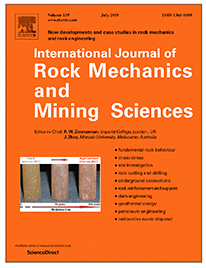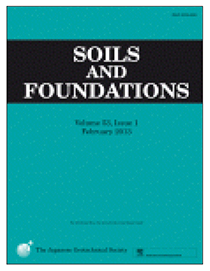국제학술회의 소식
International Conference & Symposium
대륙별 학회 (Date : Day-Month-Year)
참고 웹사이트 : https://www.issmge.org/events
2025
아메리카(북·남미)
3rd International Workshop on Landslides in Sensitive Clays
- Date: September 28 - October 02, 2025
- Venue: Quebec City, Canada
- Website: http://www.iwlsc2025.ca
- E-mail: secretariat@iwlsc2025.ca
DFI 50th Anniversary Conference on Deep Foundations
- Date: October 20-23, 2025
- Venue: Nashville, United States
- Website: http://www.dfi.org
- E-mail: tengler@dfi.org
유럽
Third Workshop on the Future of Machine Learning in Geotechnics
Date: October 15-17, 2025
Venue: Florence, Italy
Website: http://www.fomlig2025.com
E-mail: fomlig2025@aimgroup.eu
Geotechniekdag 2025-National Geotechnical Conference of the Netherlands
- Date: November 11-11, 2025
- Venue: Netherlands
- E-mail: geotechniekdag@kivi.nl
- Website: https://kivi.nl/communities/vakafdelingen/geotechniek/geotechniekdag/geotechniekdag-2025
아시아
7th International Symposium on Transportation Soil Engineering in Cold Regions
- Date: September 17-20, 2025
- Venue: Incheon, Korea
- Website: https://www.transoilcold2025.org/
- E-mail: kgs@transoilcold2025.org
Geotech Asia 2025
- Date: October 07-10, 2025
- Venue: Goa, India
- Website: https://www.geotechasia.org/
- E-mail: info@geotechasia.org
5th AsRTC6 “Urban GeoEngineering” Symposium
- Date: October 23-24, 2025
- Venue: Taipei, Chinese Taipei
- Website: https://www.asrtc6urbangeoengineering2025.com/index.html
- E-mail: geogroup@asrtc6urbangeoengineering2025.com
17th International Conference on Geotechnical Engineering & 8th International Symposium on Natural Hazards
- Date: December 04-05, 2025
- Venue: Lahore, Pakistan
- Website: http://www.17icge-8isg.com
- E-mail: tmasood267@yahoo.com
2026
유럽
15th International Conference "Modern Building Materials, Structures and Techniques"
- Date: May 12-15, 2026
- Venue: Vilnius, Lithuania
- E-mail: mbmst@vilniustech.lt
- Website: https://www.rilem.net/agenda/15th-international-conference-modern-building-materials-structures-and-techniques-1650
8th International Young Geotechnical Engineers Conference
- Date: June 11-14, 2026
- Venue: Graz, Austria
- Website: https://iygec2026.tugraz.at
- E-mail: iygec2026@tugraz.at
21st International Conference on Soil Mechanics and Geotechnical Engineering
- Date: June 14-19, 2026
- Venue: Vienna, Austria
- Website: https://www.icsmge2026.org/en/
- E-mail: helmut.schweiger@tugraz.at
International Conference on Advances and Innovations in Soft Soil Engineering 2026
- Date: August 24-26, 2026
- Venue: Delft, Netherlands
- Website: TBA
- E-mail: s.muraro@tudelft.nl
CREST 2026
- Date: September 7-8, 2026
- Venue: Cambridge, United Kingdom
- Website: https://engage-events.ifm.eng.cam.ac.uk/IC-CREST2026
Fourth International Symposium on Geotechnical Engineering for the Preservation of Monuments and Historic Sites
- Date: September 16-18, 2026
- Venue: Athens, Greece
- Website: https://tc301-athens.com
- E-mail: secretary@tc301-athens.com
6th International Conference on Information Technology in Geo-Engineering
- Date: October 13-16, 2026
- Venue: Graz, Austria
- Website: https://www.icitg2026.com/
- E-mail: georg.erharter@ngi.no
아시아
2026 SOUTHEAST ASIAN GEOTECHNICAL CONFERENCE
- Date: January 28-30, 2026
- Venue: Taguig, Philippines
- Website: https://pssmge.org/
- E-mail: seagc.agssea@2026@gmail.com
Pan Mediterranean Geotechnical Engineering Conference
- Date: March 25-28, 2026 o Venue: Beirut, Lebanon
- Website: http://pmgec-leb.com/
- E-mail: contact@pmgec-leb.com
8th International Conference on Geotechnics, Civil Engineering and Structures (CIGOS)
- Date: April 16-17, 2026
- Venue: Ho Chi Minh city, Vietnam
- Website: https://cigos2026.sciencesconf.org/
- E-mail: cigos@avseglobal.org
12th International Symposium on Field Monitoring in Geomechanics 2026
- Date: August 06-10, 2026
- Venue: Indore, India
- Website: https://isfmg2026.com/
- E-mail: convener@isfmg2026.com
International Conference on Geotechnical Engineering | ICGE-Colombo 2026
- Date: August 24-25, 2026
- Venue: Colombo, Sri Lanka
- Website: https://icgecolombo2026.org/
- E-mail: slgssecretariat@gmail.com
오세아니아
Landslide Geo-Education and Risk(LaGER) 2026 - JTC1 & JTC3 workshop
- Date: April 28-May 01, 2026
- Venue: Queenstown, New Zealand
- Website: http://landsliderisk.nz
- E-mail: ross.roberts@gmail.com
아프리카
10th African Young Geotechnical Engineers Conference
- Date: April 26-29, 2026
- Venue: Lagos, Nigeria
- Website: https://nige.org.ng
- E-mail: nsegeotechdiv@yahoo.co.uk
유민택
가천대학교 토목환경공학과 조교수
mintaekyoo@gachon.ac.kr
해외매거진 소개
Journal of Geotechnical and Geoenvironmental Engineering
Volume 151, Issue 8 (August 2025) / https://ascelibrary.org/toc/jggefk/151/8

목차
Technical Papers
Journal of Geotechnical and Geoenvironmental Engineering
Volume 151, Issue 9 (Septembert 2025) / https://ascelibrary.org/toc/jggefk/151/9

목차
Technical Papers
Géotechnique
Volume 75, Issue 7 (July 2025) / https://www.emerald.com/jgeot/issue/75/7
_0.png)
목차
Research Articles
Microscale insights into enzyme-induced carbonate precipitation in rock-based microfluidic chips
Yang Xiao, Chang Zhao, Hao Cui, Yanbo Chen, Bingyang Wu, Hanlong Liu
The impact of thermal-hydraulic variation on tunnel long-term performance: a tale of two tunnels
Chao Wang, Zhipeng Xiao, Vanessa Di Murro, John Osborne, Miles Friedman, Zili Li
Salinity and oven-drying effects on the plasticity of a marine soft clay
Laxmi Suwal, Jubert Andres Pineda, Brett Turner, Guido Musso
Approximate upper- and lower-bound analyses of translational rainfall-induced landslides in curvilinear hillslopes
Longfei Zhang, Wangcheng Zhang, Yang Wang, Ashraf Osman
Capturing the random mechanical behaviour of granular materials: a comprehensive stochastic discrete-element method study
DeYun Liu, Meng-Ze Lyu
Coupled filtration-consolidation model for vacuum-preloaded soft ground
Hao Zhang, Yu-Jun Cui, Hong-Lei Sun, Yuan-Qiang Cai
In situ water retention monitoring system of an operational dyke
Zsombor Illés, ÖRs Antal, LASzlO Nagy
Reliability of dynamically embedded anchors in soft clay
Joe G. Tom, Conleth D. O’loughlin, David J. White
An investigation of the behaviour of polymer fluids in the American Petroleum Institute filter press
Daniel P. Mcnamara, Brian B. Sheil, Stephan A. Jefferis, Chris Barker, Duncan Nicholson
Discussion
Lateral load response of large-diameter monopiles in sand Free
Qian Hu, Fei Han, Monica Prezzi, Rodrigo Salgado, Minghua Zhao, H. Wang; B. M. Lehane, M. F. Bransby, A. Askarinejad, L. Z. Wang
Canadian Geotechnical Journal
Volume 62, 2025(continuous publication model) / https://cdnsciencepub.com/toc/cgj/62

목차
Research Articles
International Journal of Rock Mechanics and Mining Sciences
Vol.192 (August 2025) /
/ https://www.sciencedirect.com/journal/international-journal-of-rock-mechanics-and-mining-sciences/vol/192/suppl/C

목차
International Journal of Rock Mechanics and Mining Sciences
Vol.193 (September 2025) /
/ https://www.sciencedirect.com/journal/international-journal-of-rock-mechanics-and-mining-sciences/vol/193/suppl/C

목차
Soils and Foundations
Volume 65, Issue 4 (August 2025)
/ https://www.sciencedirect.com/journal/soils-and-foundations/vol/65/issue/4

목차
유민택
가천대학교 토목환경공학과 조교수
(mintaekyoo@gachon.ac.kr)
논문집 개요 소개
논문집 개요 소개 | 2025년 8월 제 41권 4호
유전상수 변화에 따른 GPR 기반 지중관로 탐사 효율화 연구
도해주 (정회원, 부산대학교 사회환경시스템공학과 박사과정)
오태민 (정회원, 부산대학교 사회환경시스템공학과 부교수, geotaemin@pusan.ac.kr)
이동현 (비회원, 부산대학교 사회환경시스템공학과 석사과정)
류희환 (정회원, 한국전력공사 전력연구원 책임연구원)
GPR(Ground Penetrating Radar)을 활용한 지반 탐사 기술은 레이다를 지반이나 구조물로 전파하여 반사파를 분석하는 기술이다. GPR 탐사 기술은 비파괴적으로 지질 구조 및 지하 매설물 등의 위치 파악 목적으로 활발히 활용되고 있다. 유전상수는 전자기파와 원시데이터의 해상도를 결정하는 GPR 기술의 주요인자이다. 따라서 GPR을 활용한 지반 탐사를 수행할 때, 그 지반의 유전상수에 대한 영향을 필수적으로 고려해야 한다. 하지만 기존 연구에서의 유전상수 산정 방법은 현장에서 신속하게 할 수 없어 많은 사전 조사들이 수행되어야 한다. 따라서 본 연구에서는 지반의 유전상수에 따른 원시 데이터의 품질을 분석하여 현장 지반 탐사 적합 유전상수를 산정하였다. 본 연구결과는 GPR 기술을 활용한 현장 지반 탐사를 위한 지반 유전상수 산정의 기초자료로 유용하게 활용될 것으로 기대된다.
이동 경화 모델을 활용한 압축 벤토나이트 완충재의 동적 거동 평가에 관한 기초연구
조성인 (정회원, 인하대학교 토목공학과 석사과정)
나선홍 (정회원, 인하대학교 사회인프라공학과 부교수, s.na@inha.ac.kr)
심층 처분 시스템은 지하 500m 이상의 대심도에 설치되어 고준위 방사성폐기물을 영구적으로 격리기 위한 시설이다. 이 시스템은 심층 암반으로 구성된 천연방벽과 고준위 폐기물이 저장된 용기를 감싸는 공학적 방벽으로 구성되며, 후자는 완충재로 압축 벤토나이트 적용이 검토되고 있다. 최근 국내에서 지진 발생 빈도가 증가함에 따라, 반영구적인 수명이 요구되는 심층 처분장의 대규모 지진에 대한 안정성 평가의 중요성이 부각되고 있다. 본 연구는 압축 벤토나이트 완충재의 대규모 지진에 대한 동적 거동을 평가하기 위한 기초연구로서, 유한요소법을 기반으로 탄소성 거동 및 지진파 특성을 반영한 동적 수치해석을 수행하였다. 특히, 반복 하중에 따른 완충재의 비선형 거동을 보다 합리적으로 모사하기 위하여 이동 경화 소성 모델을 적용하였으며, 극한 시나리오를 고려하여 최대 진폭이 0.05g에서 0.5g까지의 10종의 보정 지진파를 입력하여 시간이력해석을 수행하였다. 해석 결과, 완충재 내에서 동적 하중에 의한 응력-변형 이력 현상과 더불어 팽윤 특성이 관찰되었으며, 국내에서 발생한 실제 지진파에 대해서는 비교적 안정적인 응력-변형 거동을 유지함을 확인하였다.
PCM 혼입 모르타르 패널 적용에 따른 옹벽 배면 동결영역 저감 효과에 대한 수치해석 연구
우현재 (비회원, 국립금오공과대학교 건축토목환경공학부 석박통합과정)
고규현 (정회원, 국립금오공과대학교 건축토목환경공학부 부교수, 교신저자, gyuhyungo@kumoh.ac.kr)
이재민 (비회원, 국립금오공과대학교 국립금오공과대학교산학협력단 박사후연구원)
김성겸 (비회원, 국립금오공과대학교 건축토목환경공학부 조교수)
최근 세계적으로 이상 기후가 빈번하게 발생하고 있고, 특히 국내에서는 겨울철 극한 한파의 빈도가 증가하고 있는 추세이다. 극한 한파에 의해 발생하는 지반의 동결-융해는 지반 구조물에 심각한 손상을 야기한다. 특히 옹벽 배면에서 동결-융해가 발생할 경우 토압 및 지지력의 변화로 인해 옹벽의 안정성이 크게 저하될 수 있다. 따라서 본 연구에서는 동결-융해에 의한 옹벽 구조물의 손상을 사전에 방지하기 위한 대책으로 상변화 물질(PCM)과 시멘트 모르타르를 혼합한 패널을 옹벽에 적용하는 방법을 제안하고, 효과적으로 동결 영역을 저감할 수 있는 가능성을 실험 및 수치해석을 통해 정량적으로 평가하였다. 먼저 PCM 시멘트 모르타르 공시체를 제작하여 동결 챔버를 이용한 동결 실험을 수행하였고, 계측된 온도 데이터를 분석하여 PCM의 열적 완충 성능을 평가하였다. 또한 계측된 온도 데이터를 기반으로 PCM의 상변화 특성 및 열적 완충 성능을 모사할 수 있는 수치해석 모델을 구축하여, 모델의 정확성과 예측 신뢰도를 검증하였다. 이후 검증된 모델을 활용하여 PCM 패널 적용 여부에 따라 옹벽 배면 지반 내 온도 분포와 동결 영역 등의 변화를 비교 평가하였다. 수치해석 결과, PCM의 열적 완충 성능에 의해 배면 지반 내부에서 동결 영역이 효과적으로 감소한 것을 확인하였다. 이는 PCM 패널의 열적 완충 성능의 실효성을 나타내며, 향후 한랭 지역의 지반 구조물의 동결-융해 손상 방지 대책으로써 적용될 수 있을 것으로 판단된다.
터널 뒤채움 재료의 배합 조건에 따른 물리적 특성 분석
김태영 (정회원, 국립순천대학교 토목공학과 박사과정)
류희환 (정회원, 한국전력연구원 전력계통연구소 책임연구원)
조선아 (비회원, 한국전력연구원 전력계통연구소 선임연구원)
이해진 (비회원, 한국전력연구원 전력계통연구소 위촉연구원)
정성훈 (정회원, 국립순천대학교 토목공학과 교수, shchong@scnu.ac.kr)
쉴드 TBM 공법에서 테일보이드(tail void) 내 뒤채움재의 충전은 터널의 장기적 안정성과 지반 침하 방지를 위한 핵심 요소이다. 그러나 현재까지 뒤채움재의 유동성과 강도 등 공학적 성능을 정량적으로 평가할 수 있는 명확한 기준은 미흡한 실정이다. 기존 시험 방법은 주로 매우 낮은 w/c 조건의 시멘트 혼합 재료에 한정되고 실제 시공에서 사용되는 화학적 특성(예: 경화제 조성, 교반 시간, 첨가제 투입 순서 등)을 충분히 반영하지 못하고 있다. 이에 본 연구는 실제 현장에서 사용되는 이액형 뒤채움재를 대상으로, 재료의 화학적 특성을 고려한 혼합 순서 및 교반 시간 조건 하에 시멘트 종류, 물-시멘트비(w/c), 경화제-물비(H/W)에 따른 재료별 공학적 특성을 정량적으로 비교하였다. 특히 유동성과 압축강도 간의 상관관계를 도출함으로써, 일정 수준 이상의 유동성을 확보하면서도 요구 강도를 만족시키는 최적 배합 설계를 위한 기초자료를 제시하였다.
동적원심모형실험 시 구조물 진동 계측을 위한 딥러닝 기반 이미지 분석 기법 연구
한승재 (정회원, 공주대학교 건설환경공학과 석사과정)
한세희 (정회원, 공주대학교 건설환경공학과 석사과정)
추연욱 (정회원, 공주대학교 건설환경공학과 교수, ywchoo@kongju.ac.kr)
김정은 (비회원, 인하대학교 컴퓨터공학과 조교수)
윤수식 (비회원, 고려대학교 컴퓨터공학과 조교수)
본 연구에서는 딥러닝 기반 영상 분석 기법인 You only look once(YOLO)를 활용하여 동적원심모형실험 상의 구조물 진동 변위를 측정하였다. 해당 기법의 적용성을 검증하기 위해 진동 가진기 실험을 선행으로 수행하였다. 그 결과 YOLO 기법으로 개발된 구조물 인식모델은 기존의 상용 트래킹 소프트웨어에 비해 우수한 안정성과 정확성을 보였다. 이후 원심모형실험에 이 기법을 적용하였고, 가속도계 이미지를 직접 인식하는 기법과 전처리 방식 중 가장 높은 정확도를 나타낸 Deep Image Enhancement 기법을 결합하여 평균 오차율 7.096%을 달성하였다. 또한 고속푸리에변환을 통해 유사한 주파수 특성이 도출되어 본 기법의 신뢰성을 추가로 입증하였다.
사질토와 점성토가 교호하는 지반의 굴착공사시 보일링 안정성 평가
윤현수 (정회원, 경상국립대학교 공과대학 토목공학과 박사과정)
윤성규 (정회원, 경상국립대학교 공과대학 토목공학과 공학박사
마덕웅 (비회원, 한국토지주택공사)장지건 (정회원, 광림엔지니어링)
강기천 (정회원, 경상국립대학교 공과대학 토목공학과 부교수, gkang@gnu.ac.kr)
도시화에 따라 지하공간 개발이 증가하면서 지반 굴착공사의 안정성이 중요해지고 있다. 사질토와 점성토가 교호하는 지반에서는 보일링 현상의 발생 위험도가 높으며, 실무에서는 Terzaghi 간편식과 침투해석을 적용하여 보일링 안정성을 평가한다. 그러나 보일링 안정해석시 점토층의 점착력 적용 기준이 명확하지 않아 과소 설계 또는 과도한 근입깊이로 이어질 수 있다. 본 연구는 부산OO 건설현장을 대상으로 투수계수, 침투수압, 점착력을 반영한 침투해석을 수행하였다. 그 결과, 굴착저면이 모래층인 경우 간편식과 침투해석 결과가 유사해 간편식 적용이 가능하지만, 점토층의 경우 침투해석 결과가 더 낮아 보일링 안정성 확보를 위한 보수적 설계가 필요한 것으로 나타났다.
점토지반에서 부유식 해상풍력 석션앵커의 설치 시 지반설계 평가
정나영 (정회원, 국립한국해양대학교 토목공학과 박사과정, imzero24@naver.com)
김우영 (정회원, 국립한국해양대학교 토목공학과 석사과정)
이원효 (정회원, 국립한국해양대학교 토목공학과 박사과정)
김대환 (정회원, 국립한국해양대학교 토목공학과 박사과정)
김태형 (정회원, 국립한국해양대학교 토목공학과 교수)
본 연구는 점토지반에 부유식 해상풍력 석션앵커를 설치하는 것에 대한 지반설계 평가 연구를 수행하였다. 석션앵커 착지, 자중에 의한 관입, 부압에 의한 관입, 재설치 시 고려해야 하는 사항을 검토하였다. 연구 결과, 앵커 착지 후 관입깊이에 따른 지반 깊이별 허용 과압은 지반의 전단강도 하한값을 이용하여 결정한다. 부압을 이용한 앵커 관입 시 얕은깊이 지반에서 허용 부압이 공동압력을 초과하지 않도록 해야 한다. 앵커 재설치는 앵커가 해저에서 회수된 후 1일 이내에 재설치가 필요하고 앵커의 측면전단에 대해 점토의 예민비를 고려해야 한다. 점토 지반은 침식 저항성이 모래질 퇴적지반에 비해 크나 진행 속도가 느릴 뿐이며, 궁극적으로 세굴 및 트렌치는 발생하므로 설계에서 고려해야 한다. 앵커의 수직도와 회전오차는 권장기준에서 제시한 허용기준 내에 설치가 필요하다. 해저면 경사가 5°를 초과하면 수직도 오차도 증가하므로 추가 검토가 필요하다. 해저면 경사와 앵커 수직도 및 회전오차, 세굴, 앵커 내부의 지반 융기 높이 등을 고려하여 적정 앵커 길이 산정이 필요하다.
적외선 이미지와 GAF 이미지를 활용한 공동 위치에 따른 CNN 적용성 평가
장병수 (정회원, 대전대학교 재난안전공학과 박사과정)
최원우 (정회원, 대전대학교 재난안전공학과 석사과정)
윤형구 (정회원, 대전대학교 재난안전공학과 교수, hyungkoo@dju.ac.kr)
기후 변화와 지하 개발 등으로 인해 지반에 다양한 문제가 발생하고 있으며, 이를 해결하기 위한 방법론으로 적외선이 활용된다. 본 연구의 목적은 공동 위치에 따른 열에너지 특성을 분석하기 위해 적외선 기법을 적용하는 것이며, 시각적인 데이터 처리를 효율적으로 수행하기 위해 gramina angular field(GAF) 알고리즘도 함께 적용하였다. 공동은 지표면 기준 상부(0cm), 중부(13cm) 그리고 하부(25cm)에 PVC 관으로 공동을 조성하였다. 측정된 적외선 이미지를 기반으로 CNN을 적용한 결과 상부, 중부 그리고 하부의 최종 정확도는 각각 56.7%, 56.7% 그리고 28.5%였고, AUC는 0.29, 0.24 그리고 0.37로 낮은 신뢰도를 보였다. 하지만, GAF 알고리즘으로 변환 후 CNN에 적용한 결과, 정확도는 각각 91.2%, 85.7% 그리고 88.7%, AUC는 0.92, 0.95 그리고 0.97로 신뢰성이 크게 상승한 결과를 보였다. 이와 같은 결과는 단순히 측정된 이미지보다 GAF 알고리즘을 적용한 이미지로 CNN에 적용하였을 때 공동 분류의 신뢰성이 향상됨을 시사한다.
지반 해석을 위한 ChatGPT 기반 수치해석 모델링
김태구 (비회원, 연세대학교 건설환경공학과 석사과정)
김대현 (정회원, 수원대학교 건설환경에너지공학부 조교수)
윤태섭 (정회원, 연세대학교 건설환경공학과 교수, taesup@yonsei.ac.kr)
본 연구는 대형언어모델(Large Language Model, LLM)인 ChatGPT를 활용하여 지반공학 수치해석 모델링의 자동화 가능성과 한계를 분석하였다. 대표 사례로 유한차분법(Finite Difference Method, FDM) 기반 침투 해석과 유한요소법(Finite Element Method, FEM) 기반 수리-역학적 연동 침하 해석을 선정하고, 자연어 프롬프트를 통한 코드 생성 및 반복 보완 과정을 수행하였다. ChatGPT는 코드 구조의 체계적 구성과 반복적인 수정 작업의 지원에서 강점을 보였으나, FDM에서는 경계 조건 구현 오류, FEM에서는 수치 불안정성과 약형 구성의 물리적 오류가 반복적으로 발생하였다. 두 사례 모두에서 반복적 프롬프트 보완이 필요하였고, 특히 FEM의 경우 물리적 타당성을 확보하기 위한 전문가의 개입이 필수적이었다. 이러한 결과는 문제에 대한 충분한 이해와 정교한 프롬프트 설계를 전제로 할 때, LLM이 지반공학 수치해석의 자동화에 있어 효과적인 협력 도구가 될 수 있음을 시사한다.
고성능 컴퓨팅을 활용한 사질토 시료 조성의 DEM 낙사 시뮬레이션 최적화
이진선 (정회원, 원광대학교 건설환경공학과 교수, blueguy@wku.ac.kr)
본 연구는 고성능 컴퓨팅(High Performance Computing, HPC)을 활용하여 개별요소법(Discrete Element Method, DEM)의 연산 효율과 병렬 확장성을 최적화하고자 하였다. 사질토 입자의 낙사 과정을 DEM해석으로 시뮬레이션하고, 다양한 병렬 연산 기법인 MPI(Message Passing Interface), OpenMP(Open Multi-Processing, OMP), AVX-512(Advanced Vector Extensions)를 Intel Xeon 및 AMD Threadripper CPU 환경에 적용하여 연산성능을 비교·분석하였다. 특히 동적 부하 분산(Dynamic Load Balancing, DLB) 기능을 통해 MPI 병렬화 과정에서 발생하는 연산 부하의 불균형을 개선함으로써 해석시간을 효과적으로 단축할 수 있음을 확인하였다. 본 연구는 DEM 해석에서 병렬연산 성능의 최적화를 위한 하드웨어 및 소프트웨어 설정 기준 및 벤치마킹 절차를 제시하며, 향후 사질토 입자 시뮬레이션의 실내시험 크기 확장과 연산 자원 활용의 효율화를 가능하게 할 것으로 기대한다.
원심모형실험용 강우장치 개발 및 극한강우시 사면내 침투거동 평가
윤성민 (정회원, 강원대학교 토목공학과 석사과정)
전영진 (정회원, 강원대학교 산업기술연구소 선임연구원)
정기현 (비회원, 강원대학교 토목공학과 박사과정)
김재현 (정회원, 강원대학교 토목공학과 조교수, jaehyun2@kangwon.ac.kr)
김병수 (정회원, 단국대학교 토목환경공학과 부교수)
박성완 (정회원, 단국대학교 토목환경공학과 교수)
지속적인 탄소 배출로 인한 지구 온난화는 전 지구적 이상기후를 유발하며, 극한강우의 발생 빈도 또한 증가시키고 있다. 이는 사면 내 간극수압을 급격히 상승시켜 사면붕괴 위험을 높이므로 이에 대한 대응기법이 필요한 실정이다. 본 연구는 이러한 극한강우 조건에서 사면의 침투 거동을 정량적으로 평가하기 위해, 원심모형실험에서 최대 100mm/h의 강우를 재현할 수 있는 강우장치를 개발하고 1g 및 40g 조건에서 성능을 검증하였다. 또한, 개발된 강우장치를 이용해 사질토로 구성된 무한사면에서 강우시 침투거동을 실험적으로 평가하였다. 이때, 지반을 소수화(hydrophobic) 처리하여 사면을 보호하는 사면보호공법 적용 시 침투 저항특성을 함께 평가하였다. 실험 결과, 강우장치는 목표하는 극한강우를 상사법칙에 맞게 모사하였으며, 극한강우 환경에서 소수화기법 적용은 지반 침투 거동을 효과적으로 지연시키는 것을 확인하였다.
강우시 시공방식에 따른 판넬식 옹벽 비탈면 안정성 분석
김재홍 (정회원, 동신대학교 토목환경공학과 부교수)
황대용 (비회원, (주)유신 건설사업관리부 상무)
신좌일 (정회원, 동신대학교 토목환경공학과 박사과정)
김태완 (정회원, 동신대학교 토목환경공학과 박사과정, kyoug222@naver.com)
판넬식 옹벽은 시공방식에 따라 하향식(Top-down)과 상향식(Bottom-up) 공법으로 구분되며 지형 조건에 따라 적합한 방식을 선택한다. 본 연구는 전라남도 영광군 소재의 OO현장에 설치된 판넬식 옹벽을 대상으로 시공방식(Top-down, Bottom-up)에 따라 현장 강우를 적용하여 안전율의 변화를 해석하였다. 수치해석 조건은 시공방식, 강우조건, 현장 규모, 지반 강도 등의 변수를 고려하였다. 본 연구의 현장 지형 조건에서 Top-down 방식은 시공 단계별 조건에서 우기시 기준 안전율(Fs=1.3)을 만족하였으나, Bottom-up 방식은 1단 시공 단계부터 기준 안전율을 만족하지 못하였다. 단계별 2주 시공 기간이 적용된 옹벽은 강우로 인한 급격한 안전율 저하가 발생하여 초기 시공 구간의 취약성이 나타났다. 이러한 결과는 초기 안정성 확보가 가능한 Top-down 방식이 Bottom-up 방식보다 비탈면 옹벽 시공에 유리한 방식임을 확인하였다. 향후 설계 방법들을 구체적으로 제안하기 위해서 지반 강도정수에 대한 차이와 옹벽의 비탈면 기울기 변화에 대한 시공 단계별 안전율의 상호 관계 검토가 필요할 것으로 판단된다.
충격하중에 의한 화강풍화토 입자파쇄의 실험적 평가
윤한규 (비회원, 한경국립대학교 건설환경공학부 석사과정)
김인현 (정회원, 인천대학교 건설환경공학부 박사후연구원)
백성하 (정회원, 한경국립대학교 건설환경공학부 조교수, shbaek87@hknu.ac.kr)
본 연구에서는 토공사 현장에서 채취한 화강풍화토를 인위적으로 빈입도(SP) 및 양입도(SW) 시료로 조성하고, 다양한 다짐에너지를 적용하여 실내 다짐시험을 수행하였다. 그 결과, 두 시료 모두에서 다짐에너지 증가에 따라 입자파쇄가 발생하며 입도분포곡선이 우상향했고, 입자 형상은 점차 원형에 가까워졌다. SW 시료는 SP 시료보다 파쇄 저항성이 높았으며, 입자파쇄는 전 입경 범위에서 균일하게 발생하지 않고 특정 입경대에서 단계적으로 집중되었다. 초기에는 4.75 mm 이상의 굵은 입자가 주로 파쇄되었으나, 이후에는 2.36 mm 이하의 중간 입자 및 미세입자가 파쇄의 중심이 되었다. 이러한 단계별 거동은 기존 파쇄지수로는 정량화하기 어려웠으며, 프랙탈 차원은 입경 구간별 상이한 파쇄 특성을 나타내는 데 유용하나 파쇄 특성의 전환점이 잔존량 분석 결과와 일치하지 않았다. 따라서 이러한 현상을 설명할 수 있는 새로운 정량 분석 지표 개발이 필요하다.
국내 해상 지반특성을 고려한 마찰지지 모노파일의 수치해석적 적용성 검토
경두현 (정회원, 한국전력공사 전력연구원 선임연구원)
최승하 (비회원, 연세대학교 건설환경공학과 석사과정)
신윤철 (비회원, ㈜포어시스 매니저)
이호엽 (정회원, 한국전력공사 전력연구원 선임연구원)
고준영 (정회원, 충남대학교 토목공학과 부교수)
정상엽 (정회원, 연세대학교 건설환경공학과 부교수, sychung@yonsei.ac.kr)
본 연구는 복합 환경 하중 하에서 해상 풍력 지지구조물의 극한 수평 지지력을 정밀하게 평가하기 위한 수치해석 기법을 제시한다. 기존 p-y 곡선을 기반으로 한 보-스프링(beam-spring) 모델을 설명하고, 대구경 모노파일의 거동을 보다 정확하게 해석할 수 있는 PISA(Pile Soil Analysis) 모델을 적용하였다. PISA 모델은 실규모 실험과 고정밀 3차원 유한요소해석을 통해 개발되어, 지반-구조물 상호작용의 비선형 거동을 정밀하게 반영한다. 모델 검증을 위해 원심모형실험(T9 케이스) 데이터를 사용하여 3차원 유한요소해석 결과와 보-스프링 모델 해석을 비교하였으며, 그 결과 PISA 기반 해석이 수평 변위 및 극한 지지력 예측에서 우수한 정확성을 보였다. 본 연구 결과를 통해, 해상 풍력 지지구조물의 안전하고 경제적인 설계에 기여할 수 있을 뿐만 아니라, PISA 모델이 국내의 다양한 지반 조건에 성공적으로 적용될 수 있음을 실증하여 향후 확장 적용을 위한 중요한 기술적 기반을 제공할 것으로 판단된다.
온도 및 세립분 함량에 따른 화강풍화토의 직접전단 거동 특성
류주원(정회원, 전남대학교 일반대학원 건축토목공학과)
응우옌콩한(정회원, 전남대학교 일반대학원 건축토목공학과)
장용채(정회원, 국립목포해양대학교 해양건설공학과 교수)
김영상(정회원, 전남대학교 토목공학과 교수, geoyskim@jnu.ac.kr)
본 연구에서는 에너지 지반구조물의 운영 시 인접한 지반 내에 발생시키는 온도 변화가 화강풍화토의 전단강도 및 전단 시 체적 거동 특성에 미치는 영향을 규명하고자 하였다. 이를 위해 세립분 함량(5%, 15%, 25%) 및 습윤 조건(건조, 포화), 온도(20°C, 40°C, 60°C)를 변수로 설정하고, 실제 에너지 지반구조물 내의 열전달 조건을 모사할 수 있도록 새롭게 제작한 물 순환식 온도 조절 직접전단박스를 이용하여 광주광역시 지역의 화강풍화토에 대한 열-역학적 직접전단시험을 수행하였다. 실험 결과, 건조 상태에서는 온도 변화가 화강풍화토의 전단강도 및 전단 시 체적 거동, 내부마찰각에 미치는 영향이 미미하였다. 반면, 포화 상태에서는 온도 상승에 따라 전단강도, 전단 시 체적 그리고 내부마찰각이 모두 증가하는 경향이 뚜렷하게 나타났다. 또한, 내부마찰각은 세립분 함량 증가에 따라 전반적으로 감소하는 경향을 보였다. 본 연구는 다양한 세립분 함량과 온도 조건을 동시에 고려한 화강풍화토의 전단 특성 평가를 통해, 국내 실정에 적합한 에너지 지반구조물 설계를 위한 기초 자료를 제공하고자 하였다.
인공지능(AI) 기반 그라우팅 자동화 기술의 개발 및 현장 적용성 평가
김석현 (정회원, ㈜한국지오텍 팀장)
김영욱 (정회원, 명지대학교 토목공학과 교수, yukim@mju.ac.kr)
본 연구에서는 새롭게 개발된 AI 기반 자동 그라우팅 관리 시스템의 주입 성능을 평가하고자 하였다. 현대 그라우팅 기술은 1세대부터 4세대까지 다양하며, 본 연구에서 제안된 시스템은 AI 알고리즘을 활용한 실시간 최적화 기술로 차세대 자동화 그라우팅 기술로 제시하고자 한다. 기존 기술과 AI 기반 기술을 동시에 적용하여 동일한 지반 조건에서 주입성능 등을 비교하는 현장 시험을 수행하였으며 개발된 기술의 현장 적용성을 고찰하였다. 남해군 00도로 구간에 개발된 시스템을 적용한 결과, 기존 기술 대비 주입량, 주입 시간, 그리고 투수율 감소 측면에서 탁월한 효율을 나타내어 지반 공학 분야에서 본 시스템의 효과성과 실용성을 확인하였다.
영문논문집 개요 소개
Spatial correlation effects on rock mass behavior: insights from stochastic modeling in longwall mining
Mohammad Reza Soleimanfar1, Reza Shirinabadi*, Navid Hosseini Alaee, Ehsan Moosavi1 and Ghodratollah Mohammadi1
1 Department of Petroleum and Mining Engineering, South Tehran Branch, Islamic Azad University, Corner of Kausar Blvd., Deh Haghi (Ahang) St., Southern Nabard Blvd., Pirouzi St., Tehran 1777613651, Iran
2 ?Department of Civil Engineering and Research Center for Modeling and Optimization in Science and Engineering, South Tehran Branch, Islamic Azad University, Tehran, Iran
*Correspondence: r_shirinabadi@azad.ac.ir; re.shirinabadi@gmail.com
The mechanical behavior of rock masses in longwall mining is critically influenced by spatial correlation among material properties, yet conventional deterministic mod-els often overlook this variability. Conventional deterministic models often overlook this spatial variability, leading to potentially misleading assessments of rock strength and stability. This research addresses the critical need for a nuanced understand-ing of rock mass behavior by investigating the effects of spatial correlation on stress distribution and failure mechanisms in coal seams. The primary objective is to evaluate how incorporating spatially correlated random properties can enhance the accuracy of predictions in mining operations. The study uses a three-dimensional numerical model to contrast deterministic approaches with a stochastic framework that inte-grates spatial correlation factors. The methodology involves generating a realistic random field database based on the Extreme Value stochastic model, which is then applied to simulate stress responses in the rock mass under various loading condi-tions. This 40% reduction in peak stress estimates translates to substantially different safety assessments and mining strategy recommendations compared to traditional deterministic approaches. This research underscores the necessity of adopting sto-chastic approaches in rock mass evaluations, as they provide a more accurate repre-sentation of real-world conditions. The insights gained from this study are essential for developing safer and more effective longwall mining strategies, highlighting the importance of considering spatial variability in rock mechanics. The findings con-tribute to the advancement of mining engineering by integrating advanced statistical techniques with practical applications, ultimately enhancing operational efficiency and safety in mining practices.
Data-driven approach to enhance deep foundation safety: reliable methods for predicting bored pile capacity
Usman Hasan Jalali1, Badee Alshameri1*, Muhammad Hamza Khalid1, Waqas Hassan1, Lokmane Abdeldjouad2,S. Muhammad Jamil1, Hassan Farooq1 and Zain Maqsood1
1 National University of Sciences and Technology, Islamabad, Pakistan
2 University of Ouargla, Ouargla, Algeria
*Correspondence: Badee Alshameri badee.alshameri@yahoo.com; b.alshameri@nice.nust.edu.pk
Prediction of the tensile strength of sandstones using image processing and GMDH techniques
Amin Taheri-Garavand1, Yasin Abdi2* and Yudong Zhang3
1 Mechanical Engineering of Biosystems Department, Lorestan University, Korramabad, Iran
2 Department of Geology, Faculty of Sciences, Lorestan University, Korramabad, Iran
3 School of Computing and Mathematics, University of Leicester, Leicester LE1 7RH, UK
*Correspondence: abdi.ya@lu.ac.ir
회원동정
2025년 8월 신규가입자

회원 여러분 안녕하십니까.
아침저녁으로 선선한 바람이 불어오는 9월, 어느덧 2025년도도 후반부에 접어들고 있습니다. 이번 제41권 제5호 9월호 편집 과정에 참여하면서 다시금 한 권의 학회지가 만들어지기까지 얼마나 많은 정성과 헌신이 필요한지 느낄 수 있었습니다.
이번 호에서는 이종섭 부회장님의 권두언을 통해 최근 사회적으로 큰 화두가 되고 있는 지반안전 문제와 더불어, 학계와 산업계가 함께 나아가야 할 책임과 비전을 되새길 수 있었습니다. 또한, 특별테마에서는 토공사 자동화를 위한 지능형 다짐(Intelligent Compaction) 기술을 다루어, 스마트 건설기술이 지반공학 현장에 어떻게 접목될 수 있는지를 살펴보았습니다. 아울러 드론-LiDAR 기반 비탈면 조사 및 대책시설 설치, 탈착식 보조말뚝을 이용한 신기술 시공법 등 다양한 기술기사들은 실무와 연구를 잇는 값진 통찰을 제공해 주었습니다.
이밖에도 ‘흙, 돌 그리고 나’에서는 현장의 경험을 바탕으로 한 건설기준 고찰이 담겨 있으며, ‘젊은 지반공학자’ 지면에서는 새로운 연구 세대의 포부를 확인할 수 있었습니다. 특히 학생기자단이 전하는 가천대의 활발한 활동 소식은 학회의 미래를 밝게 비추는 단면이었습니다. 또한, 회원 동정, 해외 학술지 소개, 여행스케치 등 다채로운 읽을거리도 더해져 한 권의 학회지가 풍성하게 완성될 수 있었습니다
이번 편집을 통해, 학회지가 단순한 소식지가 아니라 학문적 성과와 현장의 목소리, 그리고 세대 간의 교류가 어우러지는 소통의 장임을 다시 한번 체감하였습니다. 앞으로도 회원 여러분의 다양한 경험과 의견이 이 지면을 통해 활발히 공유되기를 기대합니다.
무더운 여름이 지나가고 가을 학술대회가 다가오는 시점에서, 회원 여러분 모두 건강 유의하시고 각자의 자리에서 풍성한 결실을 맺으시길 기원합니다. 감사합니다.
유민택
편집위원회 부위원장
가천대학교 토목환경공학과 조교수


















































